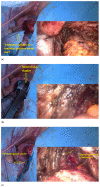Recommendations for a Combined Laparoscopic and Transanal Approach in Treating Deep Endometriosis of the Lower Rectum-The Rouen Technique
- PMID: 34068385
- PMCID: PMC8153645
- DOI: 10.3390/jpm11050408
Recommendations for a Combined Laparoscopic and Transanal Approach in Treating Deep Endometriosis of the Lower Rectum-The Rouen Technique
Abstract
The complete excision of low rectovaginal deep endometriosis is a demanding surgery associated with an increased risk of intra- and postoperative complications, which can impact the quality of life. Given the choices of optimal surgery procedures available, we would like to emphasize that a minimally invasive approach with plasma medicine and a transanal disc excision could significantly improve surgery for deep endometriosis, avoiding the lateral thermal damage of vascular and parasympathetic fibers of roots S2-S5 in the pelvic plexus. The management of low rectal deep endometriosis is distinct from other gastrointestinal-tract endometriosis nodules. Suggestions and explanations are presented for this minimal approach. These contribute to individualized medical care for deep endometriosis. In brief, a laparoscopic transanal disc excision (LTADE; Rouen technique) was performed through a laparoscopic deep rectal dissection, combined with plasma energy shaving, and followed by a transanal disc excision of the low and mid-rectal deep endometriotic nodules, with the use of a semi-circular stapler. LTADE is indicated as the first-line surgical treatment for low and mid-rectal deep endometriotic nodule excisions, because it can preserve rectal length and innervation. This technique requires a multidisciplinary team with surgical colorectal training.
Keywords: Rouen technique; laparoscopic-transanal disc excision; low rectovaginal deep endometriosis; plasma energy shaving; surgical education.
Conflict of interest statement
Professor Horace Roman and Professor Jean-Jacques Tuech received personal fees from Ethicon Endo-Surgery, Inc. for their involvement in masterclasses and training on the Rouen technique. Şerban Nastasia and Anca Angela Simionescu have no conflicts of interest nor financial ties to disclose.
Figures









Similar articles
-
Deep shaving and transanal disc excision in large endometriosis of mid and lower rectum: the Rouen technique.Surg Endosc. 2016 Jun;30(6):2626-7. doi: 10.1007/s00464-015-4528-8. Epub 2015 Sep 30. Surg Endosc. 2016. PMID: 26423408
-
Laparoscopic and transanal excision of large lower- and mid-rectal deep endometriotic nodules: the Rouen technique.Fertil Steril. 2014 Aug;102(2):e7. doi: 10.1016/j.fertnstert.2014.04.038. Epub 2014 May 23. Fertil Steril. 2014. PMID: 24864009
-
Deep rectal shaving followed by transanal disc excision in large deep endometriosis of the lower rectum.J Minim Invasive Gynecol. 2014 Sep-Oct;21(5):730-1. doi: 10.1016/j.jmig.2014.03.003. Epub 2014 Mar 12. J Minim Invasive Gynecol. 2014. PMID: 24632397
-
Surgical Outcomes after Colorectal Surgery for Endometriosis: A Systematic Review and Meta-analysis.J Minim Invasive Gynecol. 2021 Mar;28(3):453-466. doi: 10.1016/j.jmig.2020.08.015. Epub 2020 Aug 22. J Minim Invasive Gynecol. 2021. PMID: 32841755
-
Conservative Management of Rectovaginal Deep Endometriosis: Shaving Should Be Considered as the Primary Surgical Approach in a High Majority of Cases.J Clin Med. 2021 Nov 5;10(21):5183. doi: 10.3390/jcm10215183. J Clin Med. 2021. PMID: 34768704 Free PMC article. Review.
References
-
- Working group of ESGE, ESHRE, WES. Keckstein J., Becker C.M., Canis M., Feki A., Grimbizis G.F., Hummelshoj L., Nisolle M., Roman H., Saridogan E., et al. Recommendations for the surgical treatment of endometriosis. Part 2: Deep endometriosis. Hum. Reprod. Open. 2020;2020:hoaa002. doi: 10.1093/hropen/hoaa002. - DOI - PMC - PubMed
LinkOut - more resources
Full Text Sources

